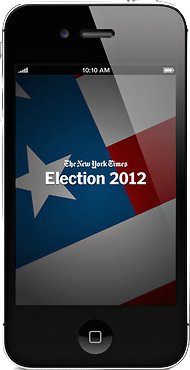 The election is over. Even the inauguration is over. So it makes sense, perhaps, that The New York Times this week discontinued its Elections 2012 mobile app.
The election is over. Even the inauguration is over. So it makes sense, perhaps, that The New York Times this week discontinued its Elections 2012 mobile app.
The Times launched the app some 13 months ago, on the eve of primary season, and the plan was always to give it an expiration date, Times emerging platforms editor Fiona Spruill told me. “We felt like that made the most sense in terms of how we were thinking about it as a product,” Spruill said. “I wouldn’t look at the fact that this app is going away as any kind of sign that we’re not going to do anything like this in the future.” (Spruill jokes that by 2016, “we’re all going to be wearing all of our political coverage” anyway.)
Election night itself brought one significant tipping point for the Times: The first moment in its history when its digital audience skewed mostly mobile. “I don’t know if we were necessarily surprised, but we were happy to learn that election night, during some of the prime time hours, of all visits to New York Times digital properties, more than 50 percent of visits were coming from mobile devices,” Spruill said. “Mobile cracked that 50 percent threshold during election night.”
But it’s still noteworthy that the Times is opting to shut down the app rather than, say, morph it into a general standalone politics app — or just rebrand it as Elections 2014 or 2016. After all, it’s already sitting on the home screens of a lot of phones. (Launching it today gives the message “Our Election 2012 Coverage Has Concluded” and pushes people to use either the Times’ main app or NYTimes.com.)
The Washington Post’s WP Politics app, which it created for the iPad during primary season, is still available in the iTunes store. The team behind that app is “transitioning our editorial production and steadily working to build out our flagship iPad product to offer just as much richness as the Politics app,” the Post’s executive producer for digital news, Cory Haik, tells me. (Disclosure: I freelance for The Washington Post.)
Back at the Times, where Spruill calls her area of the newsroom a “great, wonderful kind of sandbox for us to test out a bunch of things,” being able to ditch an app tied to a past event is in some ways liberating. “Readers can continue to get all of our political coverage in our main news app and on the website,” said Jonathan Ellis, assistant editor for digital platforms. “By retiring this app, it frees up resources to think about our next big challenge rather than maintaining.”
But there are plenty of lessons from this 13-month experiment, which Spruill says “surpassed expectations.” (She declined to say how many downloads the app got or to share metrics on engagement.) Here are three of them:
As we wrote at launch, the Elections 2012 app was one of the Times’ most vigorous forays into aggregation — including prominent links to other news orgs’ stories on the same subjects the Times was writing about.
The New York Times 2012 Election app was built primarily with HTML5; it’s since debuted an all-HTML5 web app to complement its native mobile apps.
Spruill: “It’s very important to note that our interactive news team and our graphics desk played a huge role in the success of the app — all the great work they do in terms of maps and graphics and deep databases of information…Everything we did on election night in terms of live results, they were all able to do that because the bulk of the app was HTML, so they could think about it holistically.”
The Times decided that a dedicated elections app was worth the time and resources — but that can be a tough calculation to make.
For now, the Times is applying its experience with the elections app to its main news app. That includes testing new kinds of storytelling that debuted first in the app, like clustering tweets and articles around a given topic. And Spruill’s team wants to focus squarely on 2013 before dreaming up a mobile strategy for the midterm elections or beyond.
“It’s obvious that mobile was a huge part of this election,” Spruill said. “The next election, many news organizations probably will have crossed that 50 percent threshold where they’re getting more traffic from phones and tablets. So I imagine it would be quite a bit different how many news organizations focus on their election coverage. It’s hard to say exactly what format that will take.”